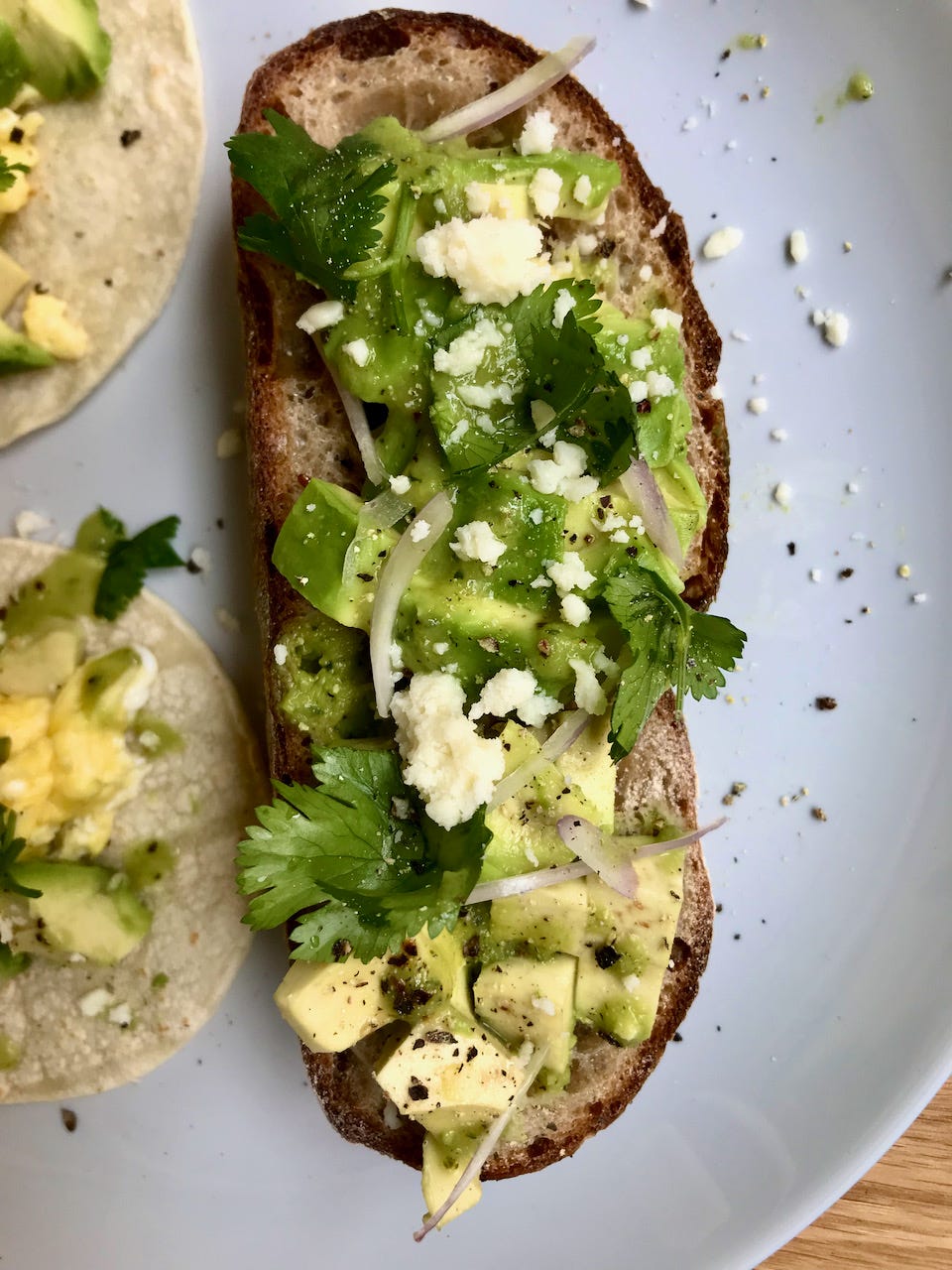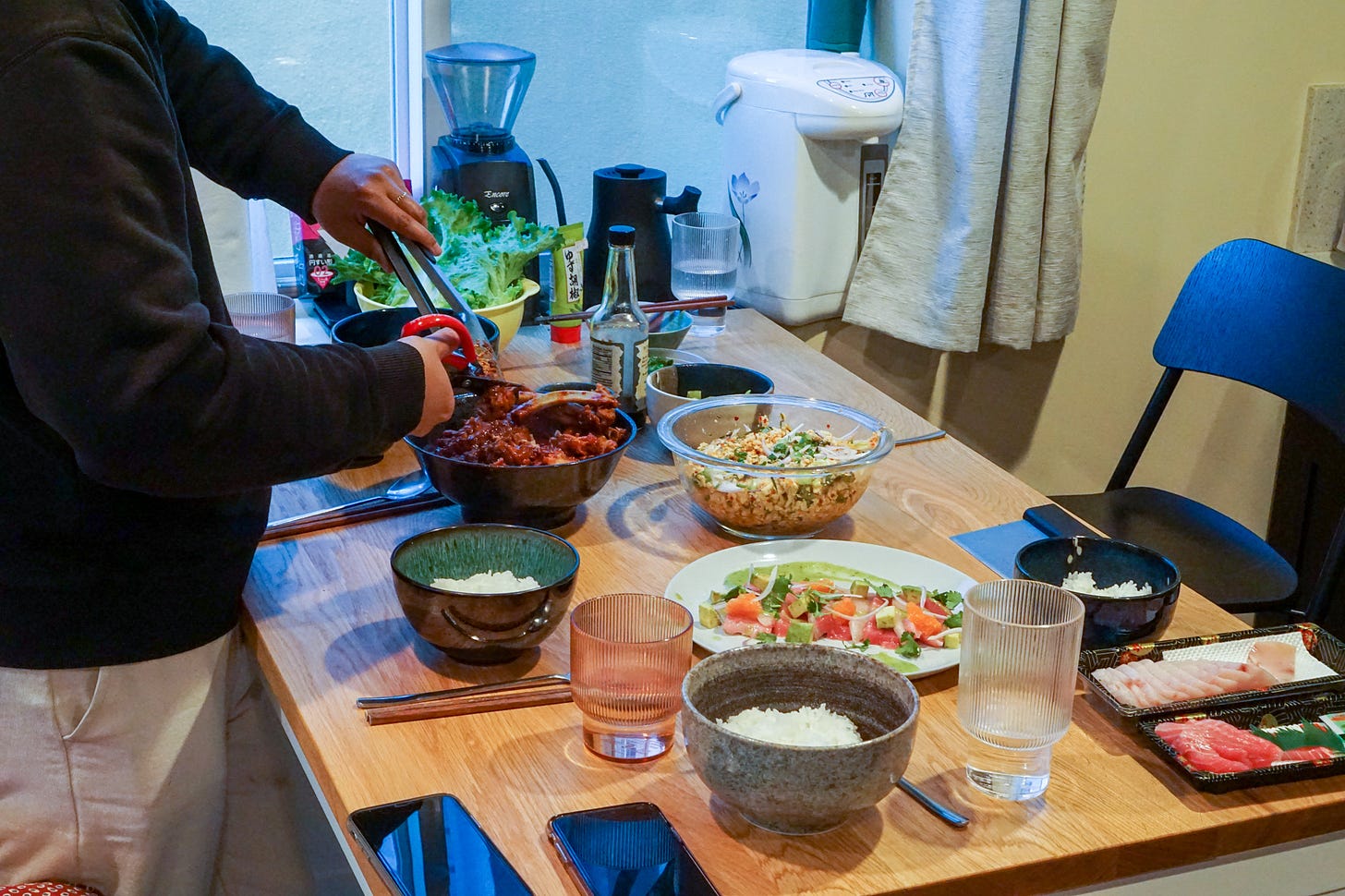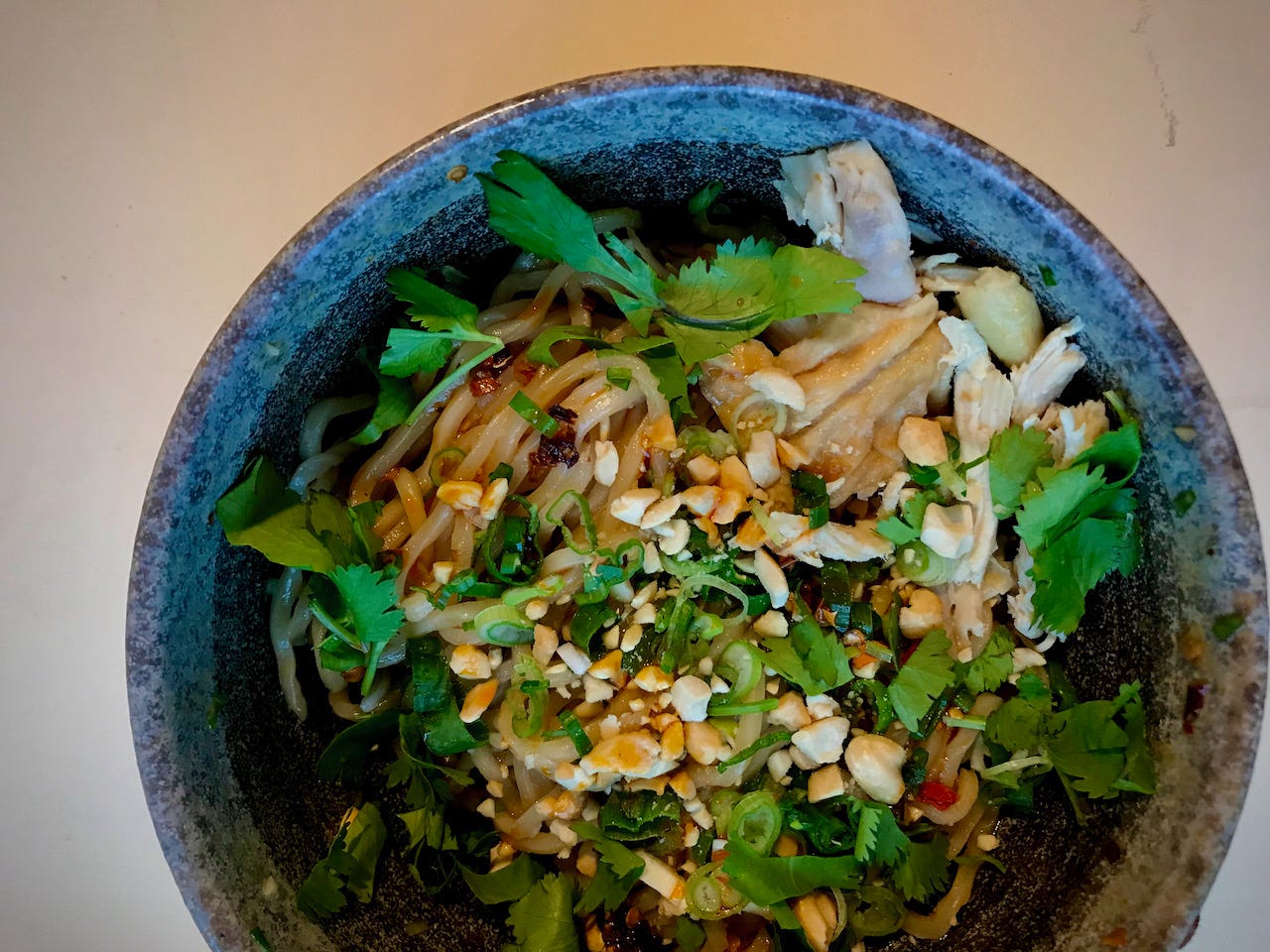cutting meat with scissors
Junhong's dwaeji kalbijjim, explorations in hospitality, and meditations on failure
Oh boy, things have gotten awfully quiet around here, haven’t they. So far, I’ve done a passable job of convincing myself that the silence is a cool and collected one, and not a panicky, feverish one – though it really has been a month since I began writing my longer-form piece on hand-pulled noodles and I’m fidgety from not even finishing my first draft. But “these things take time”, I know, so I’m telling my impulse towards hyper-productivity to shut it. In the meantime, I thought it’d be self-soothing to share what I’ve been cooking up at home lately, things I’m still chewing on.
A few weeks back, my partner and I hosted some friends for what felt like our “first big dinner event”, though it was only two other people, but hey, for our dainty, 1st-floor in-law we’re renting, it was bustling. We just moved in together and have been furnishing up our space to host more people (ie. scrambling to buy more IKEA barstools the weekend before). Lynn and Junhong also happen to love cooking so I knew I had to instigate a communal cookout and share chops. Junhong took the main, I handled the sides. I whipped up a larb chicken salad with lettuce wraps and a ceviche with aguachile. It was my first attempt at aguachile and though my ratios and consistency were a little funky, it was still satisfyingly tart, floral, and somehow simultaneously spicy and refreshing. I served it with tuna and hamachi (H-Mart coming in clutch), along with sliced shallots, cara cara orange, avocado, cilantro, and sea salt. Making just enough sauce for one dish is sort of an impossible task but the aguachile went on almost everything I cooked afterwards, including next morning’s chilaquiles and many an avocado toast.
Junhong brought kalbijjim to the table, a traditional Korean meat braise that popularly uses beef short ribs, which he substituted with pork spare ribs. “I just need a knife, cutting board, and a large pot”, he told me, and got straight to work. What really piqued my appetite was the sauce he had mixed the night before – a dark, fragrant concoction of soy sauces, oyster sauce, gochugaru, corn syrup, and other seasonings – which would become the braising liquid for his protein. The kitchen was richly scented with the intoxicating aromas of the jjim (along with the coffee I made for Lynn) as the ribs simmered to eventual tenderness. Every 15 minutes or so, Junhong would check the ribs with a fork for doneness, prodding and feeling for cues. Then, when the texture was just shy of perfect, Junhong cranked the heat to reduce the liquid into a glaze, coating the ribs as they finished.
My eyes widened at first bite, taken aback at how succulent and juicy the meat was. In other barbecue traditions, ribs tend to be enjoyed the most when they slide off the bone but I appreciated how this kalbijjim retained the slightest chew, much like how char siu ribs might. Speaking of which, the sauce showed marks of a sweet, fermented bean/wheat paste, balancing just the right amount of saltiness with unmistakable depth and complexity. There was even a touch of fruitiness to round everything out. We found ourselves rotating through every dish, each bite a relief from the last. When the hefty punch of the kalbijjim saturated our palates, we reached for crisp lettuce leaves for larb, or a slab of hamachi drenched in aguachile.
Cooking alongside Junhong gave me some sort of unspeakable joy (that I will be sure to continue pursuing) but it was watching him cut the kalbijjim with scissors that made me downright giddy. Insisting that meat (esp. high-quality meat) be cut with an expensive, razor-sharp knife is a precept that I relish in disrupting, so you can imagine my glee watching servers at upscale Korean BBQ’s butcher Hanwoo ribeye with sheers (which are also razor-sharp, btw). It’s good food without the pretense. You might ask “why scissors”, to which any right-minded Korean chef would reply, “because it’s easier” (why go through the trouble of washing an extra knife and cutting board). But I might also venture to say that it’s an extension of their hospitality, that they debone and cut the meat into manageable, bite-sized pieces so you don’t have to. Sure, I believe there is a time and place for gnawing off the bone (say, a Southern BBQ joint) but maybe there is an aspect of care and intention involved in busting out the scissors. It reminds me of the old axiom of Chinese knife technique: if I can’t pick it up with chopsticks, it’s not cut small enough (or properly).
cooking fails
Lately, I’ve been really into Jenny Dorsey’s Substack, Way Too Complicated. I wait for each entry with a similar anticipation to how I’ve waited for Attack on Titan episodes the last ten years (how about that final season though). It’s her latest personal project through which she parses the subtleties of why/how we choose to suffer, uniquely as F&B professionals, but also just as regular people. There’s plenty of cynical humor, sound wisdom and insight, and lots of memes – I seriously cannot recommend it enough. In Jenny’s words, the newsletter is a “meditation on failure”, which sounds like the exact content I need in my life.
“Beyond all the niceties of failing forward or upwards, failure is a simple reality of being human; and I like writing about it, sitting with it, befriending it.”
In writing my forthcoming noodle story, I’ve quickly re-acquired my averseness to failure, quite simply because I want so bad for it to be perfect (ugh, not this again). So I’m taking a short break from the project, in the spirit of celebrating and embracing failure. And while I’m at it, why not lean in super hard to the theme by sharing some of my biggest cooking fails these past few weeks in all their glorious, unattractive detail.
failure 1: shaobing 燒餅
Okay, this one kind of stung because I’m Taiwanese and I think we have the best breakfast in the world. For the uninitiated, shaobing is a traditional Northern Chinese flatbread made with laminated dough, baked in a tandoor-esque oven and topped with sesame seeds. I referenced Carolyn Phillips’ All Under Heaven and while it’s an amazing, indispensable resource for Chinese gastronomy, your boy needs pictures with his recipes. Not going to lie, I really struggled with those text-only instructions; made me feel really dumb re-reading the same lines every few minutes. Phillips’ recipe for shaobing is also pretty intense and involves two parts: part (a) for Northern-style laminated dough and part (b) for the shaobing itself. But I digress, my sin lied in keeping the finished laminated dough (recipe a) in the refrigerator without brushing it with oil and sealing it airtight (which you probably should be doing with all your Chinese doughs). Fridges basically act like pseudo-dehydrators so come next morning, my precious doughs were cracked like parched earth. So, no fault to Carolyn Phillips, I own up to my errors. But next time, I’m following a YouTube video.
failure 2: cold sesame noodle with shredded chicken
Another Taiwanese banger, I got this. Plot twist: I don’t got this. I loosely followed Lucas Sin’s recipe on Food&Wine (emphasis on loosely) but mostly left it up to my overconfidence, and wow, the end result was comically bad. I thought I was being conservative with the amount of sesame paste I used but the consistency ended up somewhere in the ballpark of peanut butter and gorilla glue. The noodles clumped up together so bad that I could pick up my entire bowl of noodles with chopsticks. It was ugly. In hindsight, I probably should have loosened everything up with some “pasta water”, which, of course, I poured down the sink. Yeah, I had instant ramen later that night.
I will give myself credit for thinking of a great way to use up rotisserie chicken (whose carcass I rendered into stock later that week). In a fit of self-redemption, I attempted the noodles again, this time with a quarter of the sauce and using the “you-po” method: pouring hot oil over aromatics like garlic, scallion, and chili flakes. Much more tolerable. I like how this is veering towards the direction of shagua ganmian – hilariously translating as “Idiot’s Dry Noodle” – a dish I’m now motivated to make solely because of its name.
failure 3: peanut cookies
If you’ve ever been to a traditional Taiwanese or Macau-style bakery, you might be familiar with almond cookies (I recently had one at Soon&Soon Souvenir Shop in SF Chinatown). Supermarket versions tend to be dry and brittle, but when baked fresh, they are transcendent, and really go to show just how pale and underwhelming most industrially-grown nuts are in the States. Just go to Taiwan and try their fresh almond or soy milk; it will change your life (Oatly ain’t got nothin on us). Southern Taiwan has a history of growing peanuts, which has inspired the locally-famous Penghu peanut brittle, along with a slew of other treats. Not to mention, we love to douse sweet peanut powder on everything.
I’m trying to recreate this peanut flavor, though in the format of the almond cookie – it’s merely one of the latest entries in my ever-growing catalogue of nostalgic flavors. Just as I suspected, I could hardly find any solid recipes online, at least in the English language. I did find one on this blog, presumably run by a Chinese mom, but had to google translate everything; needless to say, I had plenty of room for error. The process was actually pretty straightforward and easy to follow (yes, pictures!), and your boy remembered to cover with plastic wrap. But the end result, while very peanut-y and fragrant, had a sharp bitterness that overwhelmed everything else. The consistency was straying towards brittle supermarket quality but I didn’t mind that so much as the bitterness. Aiyah. So close yet so far.
Upon further research, I’m finding out that too much bitterness in baked goods may a symptom of adding too much baking soda or powder. A likely diagnosis, as the recipe calls for both baking powder and ammonium carbonate, which I thought were… the same thing? Basically, I may have added double the amount of baking powder than was needed. I was also hoping to have a softer, chewier texture than the crumble I ended up with. This is what I get for trying to modify a recipe that I haven’t even tried yet (not my first time doing this). Lesson learned; I’m going straight for the almond cookie next time, then I’ll create my own Taiwanese peanut spinoff once I’ve gotten the hang of it.
Whew, that wasn’t so bad, was it. I have to say, it is too tempting to only share the well-plated, delicious meals on here but that would kind of go against the sort of work I had originally set out to do. To sit with failure, to befriend it, and to share it freely – even if they are small and silly mistakes – can be a practice in authenticity. As much as I look up to Jenny Dorsey (and others) for their work, it’s those moments when they share their mistakes – forgetting to salt their eggs, burning the steak, and the like – that profoundly connect me to them in a way that “perfection” never could. It shows me a self in process. In little ways, it humanizes them.
personal things from the week
Listening to: This Can’t Be Life by Jay-Z, RAMONA PARK BROKE MY HEART by Vince Staples
Watching: Attack on Titan Final Season: Part 2 (hhnnngnngng)
Reading: The Food of Sichuan by Fuschia Dunlop
Drinking: Steady State Panama Creativa Agustin Gomez, V60
Nice thing I did for myself this week: I talked about my feelings.












